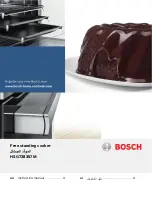
5
To light a burner:
1. press the ignition switch marked by a small
spark ( );
2. push the relevant control knob in completely
and turn it anticlockwise to the maximum position
( );
3. upon ignition, keep the knob pushed down for
about 5 seconds. This will allow the
"thermocouple" (see picture - D) to be heated
and the safety device to be switched off, otherwise
the gas supply would be interrupted;
4. then, check the flame is regular and adjust it
as required.
If the burner does not ignite, turn the control knob to zero,
and try again.
If after a few attempts the burner does not ignite, check
that the burner cap and crown (see picture - A, B) are
correctly positioned.
To interrupt the supply of gas, turn the knob in a
clockwise direction to the position " ".
When switching on the mains, after installation or
a power cut, it is quite normal for the spark
generator to be activated automatically.
If you use a saucepan which is smaller than the
recommended size, the flame will spread beyond
the bottom of the pan, causing the handle to
overheat.
As soon as a liquid starts boiling, turn down the
flame so that it will barely keep the liquid
simmering.
Take care when frying food in hot oil or fat,
as the overheated splashes could easily
ignite.
If the control knobs become difficult to turn, please
contact your local Service Force Centre.
Burner
minimum
maximum
diameter
diameter
Large (rapid)
160 mm.
260 mm.
Medium (semi-rapid)
120 mm.
220 mm.
Small (auxiliary)
80 mm.
160 mm.
The Gas Burner Controls
To ensure maximum burner efficiency, you should only
use pots and pans with a flat bottom fitting the size of
the burner used (see table).
A
- Burner Cap
B
- Burner crown
C
- Spark generator
D
- Thermocouple
Hob Control knobs (Fig. 1)
The knobs for using the gas hob are found on the control
panel. The knobs are marked with the following symbols:
•
No gas supply
Maximum gas supply
Minimum gas supply
This appliance is equipped with a safety-valve. In case
of extinction of the flame this device will operate stopping
gas supply (ex.: overflowing, draughts).






































